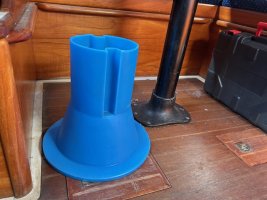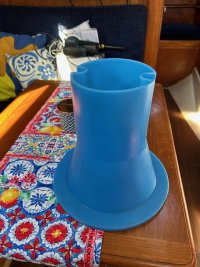-

Untitled Document The 2024-2025 Fund Raising Season has Opened!
EricsonYachts.org has opened the season for raising funds to support the expenses of the site. If you would like to participate, please see the link below for additional information.
Thanks so much for your continued support of EricsonYachts.org!
You are using an out of date browser. It may not display this or other websites correctly.
You should upgrade or use an alternative browser.
You should upgrade or use an alternative browser.
Found a strange, blue part in the lazarette | What the heck is it?
- Thread starter AdventurousAnton
- Start date
It might be an aid to repacking a spinnaker where you pull the chute thru (once you have the sides ("tapes") sorted out. And, slide rubber bands onto the 'sausage' you are making as it slides thru. I am not really sure tho, as I have never raced on a large boat where that system was used. This system allows you to load all the rubber bands first onto the "funnel".
AdventurousAnton
Member II
Hm...fascinating. My spinny is wrapped up snug as a bug in it's bag, but I might just see how it works. In the meantime, the big, blue "spool" goes into the spinny bag for later use.
THANKS!
THANKS!
peaman
Sustaining Member
For a few years I was lead foredeck on a 45 ft boat racing in Chesapeake Bay (Carrot, of West River). While the image looks more “advanced” that what we used, it definitely looks like it is intended for repacking a chute and securing with rubber bands. The bands we used were really fine, like fat monofilament diameter. The spinnaker could be fully hoisted, and as soon as the two lower corners (tack and clew) were stretched apart, the bands would start breaking as the chute filled from the bottom up. Packing was done with two people. One pulling the chute through the funnel, the other holding the funnel between his knees and sliding bands off onto the chute every couple of feet, depending on wind. Then the chute would be carefully serpentined into the bag, with corners left at the top ready for rigging and hoist.
AdventurousAnton
Member II
Fortunately, I've been the "squirrel" on racing boats but never had to repack the sails. Or maybe, unfortunately? Great input, guys!
I am told that the method fell out of favor ability because of the environmental issues of dumping rubber bands into the water. I had seen it used last year in a shorthanded race at the start in the Napa river (SSS Vallejo 2 o2 1, 2). The skipper told me he uses bio-degradable materials and was quite serious about it. I gather the question gets asked often.
AdventurousAnton
Member II
I wondered about the "rubber band" aspect of the device. I may leave it with Blue Pelican to resell and learn to pack up my kite without it.
peaman
Sustaining Member
We had a few different chutes, but only one or two were packed with rubber bands. To repack without, follow and gather the side and bottom tapes. then pack the belly into the bag. Leave the tapes on top, and tie the corners together with the drawstring of the bag. That's always worked for me.I wondered about the "rubber band" aspect of the device. I may leave it with Blue Pelican to resell and learn to pack up my kite without it.
Yup.We had a few different chutes, but only one or two were packed with rubber bands. To repack without, follow and gather the side and bottom tapes. then pack the belly into the bag. Leave the tapes on top, and tie the corners together with the drawstring of the bag. That's always worked for me.
The rubber bands were for putting a spinnaker up in "stops", in windy conditions when you didn't want it to fill early.
There are much faster ways to pack a kite if it doesn't need to be stopped. My go-to method in buoy races was (assuming the kite came down through the forward hatch)
-- go forward and find some section of the foot-tape (usually white)
-- bring it aft, along with the bag, and sit on the upper step of the companionway
-- trace the foot-tape all the way to each corner, then stuff the whole foot into the bag (leaving the corners out)
-- trace one of the luff-tapes (usually red or blue) all the way to the head, and leave it off to the side
(#ProTip - you don't have to trace both luffs - if you trace the foot and one luff, the sail can't possibly be twisted)
-- stuff the whole middle of the sail into the bag, working your way from the bottom up.
-- finally, put the traced tape on top, and leave the head sticking out of the turtle
Ideally, you end up (very quickly!) with a pack where the corners are out, the tapes are clear on top and the belly of the kite is in the bag. It'll come out clean every time and - with practice, and the occasional note of panic in the tactician's voice - only takes a minute or two to do. Even on a SC-70...



